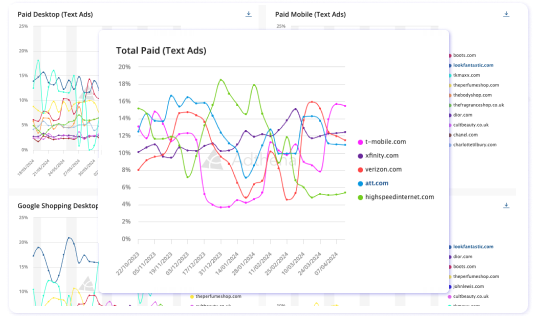While manual research can still play a role in PPC Competitor Analysis, especially for qualitative insights, the complexity of the PPC landscape makes technology essential for comprehensive, accurate, and timely competitive analysis.
Adthena’s Whole Market View technology leverages AI-powered search intelligence to provide real-time insights into competitors’ PPC strategies, including keyword targeting, ad copy, and market share.
Monitor the Market Trends to stay ahead of competitor strategies
With Adthena’s Market Trends, you can easily track changes in search term popularity, monitor fluctuations in Cost Per Click (CPC), and identify new entrants or exits in the market.
By leveraging these insights, you can proactively adjust your PPC campaigns, capitalize on new opportunities, and make data-driven decisions to optimize your search marketing performance.

Understand your PPC Market Share and see who’s winning in your market
Adthena’s Market Share provides comprehensive insights into your position relative to competitors across various search terms, ad formats, and devices, enabling you to:
- Quantify your share of voice in the PPC market
- Identify top competitors and their relative market positions
- Track changes in market share over time
- Discover opportunities for expansion or areas where market share is at risk
Market Share enables brands to benchmark their performance, detect threats from competitors, and identify opportunities for growth.

How Adthena customers have leveraged PPC Competitor Analysis
- Identifying emerging competitors: An e-commerce company used Adthena’s Market Share feature to monitor their PPC landscape. They noticed a new competitor rapidly gaining market share in certain product categories. This early detection allowed them to adjust their strategy proactively, protecting their market position.
- Optimizing seasonal strategies: A travel agency leveraged the Market Trends feature to analyze historical data on PPC activity in their industry. They identified specific periods when competitors increased their ad spend and adjusted their own budget allocation accordingly, resulting in improved visibility during peak booking seasons.
- Refining keyword strategy: A software company used the Whole Market View to analyze competitors’ keyword strategies. They discovered several high-performing long-tail keywords that their competitors were targeting but they had overlooked. By incorporating these keywords into their own campaigns, they saw a significant increase in qualified leads.
- Benchmarking performance: A retail brand used the Market Share feature to benchmark their PPC performance against top competitors. This analysis revealed that while they had a strong share of voice for branded terms, they were underperforming in non-branded category keywords. This insight guided a strategic shift in their keyword targeting approach.
- Spotting changes in PPC activity: During a major industry event, a tech company used the Market Trends feature to monitor real-time changes in PPC activity. They noticed a sudden increase in bidding on event-related keywords and quickly adjusted their strategy to maintain visibility, resulting in a surge of qualified traffic to their website.













